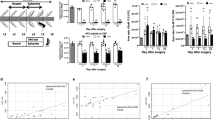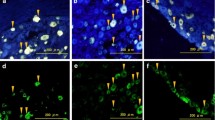Abstract
Purpose
Phosphodiesterase inhibitors possess anti-inflammatory properties. In addition, some studies report that phosphodiesterase 2A (PDE2A) are highly expressed in the dorsal horn of the spinal cord. The present study aimed to investigate whether intrathecal administration of Bay 60-7550, a specific PDE2A inhibitor, could alleviate mechanical allodynia in non-compressive lumbar disc herniation (NCLDH) rats.
Methods
Rat NCLDH models by autologous nucleus pulposus implantation to dorsal root ganglion were established. Vehicle or Bay 60-7550 (0.1, 1.0 mg/kg) was injected by intrathecal catheter at day 1 post-operation. The ipsilateral mechanical withdrawal thresholds were analyzed from the day before surgery to day 7 after surgery. At day 7 post-operation, the ipsilateral lumbar (L4–L6) segments of the spinal dorsal horns were removed, and tumor necrosis factor α (TNF-α), interleukin-1β (IL-1β), interleukin-6 (IL-6), cyclic adenosine monophosphate (cAMP), and cyclic guanosine monophosphate (cGMP) expressions were measured by ELISA. Furthermore, PDE2A mRNA and protein expressions in spinal cord were measured by Real-Time PCR and Western blot.
Results
Intrathecal administration of the PDE2A inhibitor Bay 60-7550, significantly attenuated mechanical allodynia, down-regulated spinal TNF-α, IL-1β and IL-6 over-expressions, increased the expression of spinal cAMP, as well as cGMP in a more remarkable manner, and decreased the spinal PDE2A expression in NCLDH rats in a dose-dependent manner.
Conclusions
Bay 60-7550 alleviated mechanical allodynia and inflammation in NCLDH rats, which might be associated with increased cAMP and especially cGMP increase. Thus, spinal PDE2A inhibition might represent a potential analgesic strategy for radiculopathy treatment in non-compressive lumbar disc herniation.




Similar content being viewed by others
References
Miao GS, Liu ZH, Wei SX, Luo JG, Fu ZJ, Sun T (2015) Lipoxin A attenuates radicular pain possibly by inhibiting spinal ERK, JNK and NF-kappaB/p65 and cytokine signals, but not p38, in a rat model of noncompressive lumbar disc herniation. Neuroscience 300:10–18
Murata Y, Onda A, Rydevik B, Takahashi K, Olmarker K (2004) Distribution and appearance of tumor necrosis factor-alpha in the dorsal root ganglion exposed to experimental disc herniation in rats. Spine 29(20):2235–2241
Takahashi SK, Satoh K, Sekiguchi M, Kikuchi S, Konno S et al (2012) Local application of nucleus pulposus induces expression of P2X3 in rat dorsal root ganglion cells. Fukushima J Med Sci 58(1):17–21
Zhang JJ, Song W, Luo WY, Wei M, Sun LB, Zou XN, Liao WM (2011) Autologous nucleus pulposus transplantation to lumbar 5 dorsal root ganglion after epineurium dissection in rats: a modified model of non-compressive lumbar herniated intervertebral disc. Chin Med J (Engl) 124(13):2009–2014
Walter BA, Purmessur D, Likhitpanichkul M et al (2015) Inflammatory kinetics and efficacy of anti-inflammatory treatments on human nucleus pulposus cells. Spine (Phila Pa 1976) 40(13):955–963
Haj SZ, Bedioune I, Lechene P et al (2014) Control of cytoplasmic and nuclear protein kinase A by phosphodiesterases and phosphatases in cardiac myocytes. Cardiovasc Res 102(1):97–106
Ding L, Zhang C, Masood A et al (2014) Protective effects of phosphodiesterase 2 inhibitor on depression- and anxiety-like behaviors: involvement of antioxidant and anti-apoptotic mechanisms. Behav Brain Res 268:150–158
Bubb KJ, Trinder SL, Baliga RS, Patel J, Clapp LH, MacAllister RJ, Hobbs AJ (2014) Inhibition of phosphodiesterase 2 augments cGMP and cAMP signaling to ameliorate pulmonary hypertension. Circulation 130(6):496–507
Kedia GT, Oelke M, Sonnenberg JE et al (2014) Phosphodiesterase isoenzymes in the human urethra: a molecular biology and functional study. Eur J Pharmacol 741:330–335
Silverman RH, Weiss SR (2014) Viral phosphodiesterases that antagonize double-stranded RNA signaling to RNase L by degrading 2-5A. J Interferon Cytokine Res 34(6):455–463
Redrobe JP, Jorgensen M, Christoffersen CT et al (2014) In vitro and in vivo characterisation of Lu AF64280, a novel, brain penetrant phosphodiesterase (PDE) 2A inhibitor: potential relevance to cognitive deficits in schizophrenia. Psychopharmacology 231(16):3151–3167
Gasser C, Taiber S, Yeh CM, Wittig CH, Hegemann P, Ryu S, Wunder F, Möglich A (2014) Engineering of a red-light-activated human cAMP/cGMP-specific phosphodiesterase. Proc Natl Acad Sci USA 111(24):8803–8808
Laurent Gomez J, Breitenbucher Guy (2013) PDE2 inhibition: potential for the treatment of cognitive disorders. Bioorg Med Chem Lett 23:6522–6527
Stephenson DT, Coskran TM, Kelly MP et al (2012) The distribution of phosphodiesterase 2A in the rat brain. Neuroscience 226:145–155
Bubb KJ, Trinder SL, Baliga RS et al (2014) Inhibition of phosphodiesterase 2 augments cGMP and cAMP signaling to ameliorate pulmonary hypertension. Circulation 130(6):496–507
Kallenborn-Gerhardt W, Lu R, Bothe A et al (2014) Phosphodiesterase 2A localized in the spinal cord contributes to inflammatory pain processing. Anesthesiology 121(2):372–382
Stephenson DT, Coskran TM, Wilhelms MB et al (2009) Immunohistochemical localization of phosphodiesterase 2A in multiple mammalian species. J Histochem Cytochem 57(10):933–949
Plummer MS, Cornicelli J, Roark H et al (2013) Discovery of potent selective bioavailable phosphodiesterase 2 (PDE2) inhibitors active in an osteoarthritis pain model. Part II: optimization studies and demonstration of in vivo efficacy. Bioorg Med Chem Lett 23(11):3443–3447
Plummer MS, Cornicelli J, Roark H, Skalitzky DJ, Stankovic CJ, Bove S et al (2013) Discovery of potent, selective, bioavailable phosphodiesterase 2(PDE2) inhibitors active in an osteoarthritis pain model, Part I: transformation of selective pyrazolodiazepinone phosphodiesterase4 (PDE4) inhibitors into selective PDE2 inhibitors. Bioorg Med Chem Lett 23(11):3438–3442
Kim SJ, Park SM, Cho YW, Jung YJ, Lee DG, Jang SH et al (2011) Changes in expression of mRNA for interleukin-8 and effects of interleukin-8 receptor inhibitor in the spinal dorsal horn in a rat model of lumbar disc herniation. Spine (Phila Pa 1976) 36(25):2139–2146
Chaplan SR, Bach FW, Pogrel JW, Chung JM, Yaksh TL (1994) Quantitative assessment of tactile allodynia in the rat paw. J Neurosci Methods 53(1):55–63
Liu ZH, Miao GS, Wang JN, Yang CX, Fu ZJ, Sun T (2016) Resolvin D1 inhibits mechanical hypersensitivity in sciatica by modulating the expression of nuclear factor-κB, phospho-extracellular signal-regulated kinase, and pro- and anti-inflammatory cytokines in the spinal cord and dorsal root ganglion. Anesthesiology 124(4):934–944
Yan J, Zou K, Liu X, Hu S, Wang Q, Miao X et al (2016) Hyperexcitability and sensitization of sodium channels of dorsal root ganglion neurons in a rat model of lumber disc herniation. Eur Spine J 25(1):177–185
Xie W, Tan ZY, Barbosa C, Strong JA, Cummins TR, Zhang JM (2016) Upregulation of the sodium channel NaVβ4 subunit and its contributions to mechanical hypersensitivity and neuronal hyper excitability in a rat model of radicular pain induced by local dorsal root ganglion inflammation. Pain 157(4):879–891
Ramesh Geeta, MacLean Andrew G, Philipp Mario T (2013) Cytokines and chemokines at the crossroads of neuroinflammation, neurodegeneration, and neuropathic pain. Hindawi Publ Corp Mediat Inflamm. doi:10.1155/2013/480739
Pedersen LM, Schistad E, Jacobsen LM, Roe C, Gjerstad J (2015) Serum levels of the pro-inflammatory interleukins 6 (IL-6) and -8 (IL-8) in patients with lumbar radicular pain due to disc herniation: a 12-month prospective study. Brain Behav Immun 46:132–136
Özaktay CA, Cavanaugh JM, Asik I, DeLeo JA, Weinstein JN (2002) Dorsal root sensitivity to interleukin-1 beta, interleukin-6 and tumor necrosis factor in rats. Eur Spine J 11:467–475
Martins DR, Brito RN, Stramosk J et al (2015) Peripheral neurobiologic mechanisms of antiallodynic effect of warm water immersion therapy on persistent inflammatory pain. J Neurosci Res 93(1):157–166
Kim SH, Park BN, Kim SW (2011) The effect of phosphodiesterase-4-specific inhibitor in the rat model of spinal nerve ligation. J Korean Neurosurg Soc 50(2):109–113
Francis SH, Blount MA, Corbin JD (2011) Mammalian cyclic nucleotide phosphodiesterases: molecular mechanisms and physiological functions. Physiol Rev 91(2):651–690
Hepp R, Tricoire L, Hu E, Gervasi N, Paupardin-Tritsch D, Lambolez B, Vincent P (2007) Phosphodiesterase type 2 and the homeostasis of cyclic GMP in living thalamic neurons. J Neurochem 102(6):1875–1886
Rentsendorj O, D’Alessio FR, Pearse DB (2014) Phosphodiesterase 2A is a major negative regulator of iNOS expression in lipopolysaccharide-treated mouse alveolar macrophages. J Leukoc Biol 96(5):907–915
Bombarda G, Sabino JP, Silva CA, Fazan JR, Salgado MC, Salgado HC (2011) Role of cGMP and cAMP in the hemodynamic response to intrathecal sildenafil administration. Clinics (Sao Paulo) 66(8):1407–1412
Pifarre P, Prado J, Giralt M, Molinero A, Hidalgo J, Garcia A (2010) Cyclic GMP phosphodiesterase inhibition alters the glial inflammatory response, reduces oxidative stress and cell death and increases angiogenesis following focal brain injury. J Neurochem 112(3):807–817
Zhuo M, Hu Y, Schultz C, Kandel ER, Hawkins RD (1994) Role of guanylyl cyclase and cGMP dependent Protein kinase in long-term potentiation. Nature 368:635–639
Wang L, Chopp M, Szalad A, Liu Z, Bolz M et al (2011) Phosphodiesterase-5 is a therapeutic target for peripheral neuropathy in diabetic mice. Neuroscience 193:399–410
Deshmukh R, Sharma V, Mehan S, Sharma N, Bedi KL (2009) Amelioration of intracerebroventricular streptozotocin induced cognitive dysfunction and oxidative stress by vinpocetine-a PDE1 inhibitor. Eur J Pharmacol 620:49–56
Hannila SS, Filbin MT (2008) The role of cyclic AMP signaling in promoting axonal regeneration after spinal cord ingury. Exp Neurol 209(2):321–332
Bollen E, Puzzo D, Rutten K, Privitera L, De Vry J, Vanmierio T et al (2014) Improved long-term memory via enhancing cGMP-PKG signaling requires cAMP-PKA signaling. Neuropsychopharmacology 39(11):2497–2505
Acknowledgements
All authors were involved in drafting or revising this work. This work was written by Junnan Wang. The coauthors made important improvement to the article. Zhijian Fu had full access to all data in the study and take responsibility for the integrity of the data and the accuracy of the data analysis. All authors approve the article to be published and declare no conflicts of interest. This work was supported by the National key clinical specialty on pain department of China, the National Natural Science Foundation of China (81271346) and the Natural Science Foundation of Shandong Province, China (ZR2010HM097).
Author information
Authors and Affiliations
Corresponding author
Ethics declarations
Conflict of interest
No conflict of interest exists in this paper for all authors.
Additional information
J. Wang and X. Zhao contributed equally to this work.
Rights and permissions
About this article
Cite this article
Wang, JN., Zhao, Xj., Liu, Zh. et al. Selective phosphodiesterase-2A inhibitor alleviates radicular inflammation and mechanical allodynia in non-compressive lumbar disc herniation rats. Eur Spine J 26, 1961–1968 (2017). https://doi.org/10.1007/s00586-017-5023-9
Received:
Revised:
Accepted:
Published:
Issue Date:
DOI: https://doi.org/10.1007/s00586-017-5023-9




